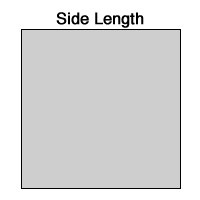Calculating square footage is a fundamental skill for homeowners, renters, and anyone involved in home improvement, gardening, or construction projects. Whether you’re planning to install new flooring, buy the right amount of paint, or determine the size of your garden, understanding How To Figure Out Square Footage is essential. This guide will walk you through everything you need to know about calculating square footage for various shapes, ensuring you get it right every time.
Understanding Square Footage and Why It Matters
Square footage is simply the measurement of area in square feet. It tells you how much surface space you have. Imagine covering a surface with square tiles that are each one foot by one foot – the number of tiles you’d need is the square footage.
Why is this important? Because square footage is used in countless practical situations:
- Home Improvement: Flooring, tiling, carpeting, painting, wallpapering – all these materials are often priced and sold by the square foot. Accurate square footage calculations prevent you from overbuying or, worse, running short mid-project.
- Gardening and Landscaping: Determining the area of garden beds, lawns, or patios helps you calculate how much soil, mulch, fertilizer, or paving stones you will need.
- Real Estate: Square footage is a key factor in determining property value and rental costs. Understanding it helps you compare different properties and assess whether you are getting the space you need.
- Construction: From estimating material costs to planning room layouts, square footage is a cornerstone of construction and design.
Knowing how to accurately calculate square footage saves you money, time, and frustration. Let’s dive into the methods.
Step-by-Step Guide to Calculating Square Footage for Rectangles and Squares
The simplest shapes to calculate square footage for are rectangles and squares. Here’s a straightforward, step-by-step process:
Step 1: Measure the Length and Width
Using a measuring tape, determine the length and width of the area you want to measure. Make sure to measure in feet.
- For a rectangular room: Measure along one of the longer walls for the length and one of the shorter, adjacent walls for the width.
- For a square room: Since all sides are equal, you only need to measure one side. This measurement will be both your length and width.
Step 2: Multiply Length by Width
Once you have your measurements in feet, multiply the length by the width. This simple calculation gives you the area in square feet.
Formula: Area (square feet) = Length (feet) × Width (feet)
Example: If your room is 12 feet long and 10 feet wide:
Area = 12 feet × 10 feet = 120 square feet
Step 3: Handling Inches and Other Units
Sometimes, measurements might involve inches or other units. Here’s how to handle them:
- Measurements in Feet and Inches: If you have measurements in feet and inches (e.g., 10 feet 6 inches), convert the inches to feet by dividing the number of inches by 12. For example, 6 inches is 6/12 = 0.5 feet. So, 10 feet 6 inches becomes 10.5 feet. Then, proceed with the multiplication.
- Measurements in Other Units: If you’ve measured in yards, centimeters, or meters, you’ll need to convert these measurements to feet before calculating square footage. Here are some common conversions:
- Yards to Feet: Multiply yards by 3 (1 yard = 3 feet)
- Inches to Feet: Divide inches by 12 (1 inch = 1/12 foot)
- Centimeters to Feet: Multiply centimeters by 0.03281 (1 centimeter ≈ 0.03281 feet)
- Meters to Feet: Multiply meters by 3.281 (1 meter ≈ 3.281 feet)
You can use online conversion tools for quick conversions if needed. Once all measurements are in feet, you can calculate the square footage as described above.
Calculating Square Footage for Different Shapes
While rectangles and squares are common, you might encounter other shapes. Here’s how to calculate square footage for some common shapes:
Square Area
As mentioned earlier, for a square, you only need the length of one side.
Formula: Area (square feet) = Side Length (feet) × Side Length (feet)
Rectangle Area
We’ve already covered this, but for clarity:
Formula: Area (square feet) = Length (feet) × Width (feet)
Rectangle Border Area
This is relevant when you have a rectangular area with a border around it, like a garden bed with a path.
Formulas:
- Inner Area: Inner Length × Inner Width
- Total Area: (Inner Length + (2 × Border Width)) × (Inner Width + (2 × Border Width))
- Border Area: Total Area – Inner Area
Circle Area
To calculate the area of a circle, you need the radius (the distance from the center of the circle to the edge) or the diameter (the distance across the circle through the center).
Formula (using Diameter): Area (square feet) = π × (Diameter/2)²
Where π (Pi) is approximately 3.14.
Circle Border Area (Annulus)
Similar to the rectangle border, this applies to circular areas with a border, like a round patio with a surrounding walkway.
Formulas:
- Outer Area: π × (Outer Diameter/2)²
- Inner Area: π × (Inner Diameter/2)²
- Border Area: Outer Area – Inner Area
Annulus Area
An annulus is the same as a circle border, but the measurements might be given as inner and outer diameters directly. The calculation is identical to the circle border area.
Formulas:
- Outer Area: π × (Outer Diameter/2)²
- Inner Area: π × (Inner Diameter/2)²
- Annulus Area: Outer Area – Inner Area
Triangle Area
For a triangle, you can use Heron’s formula if you know the lengths of all three sides (a, b, c).
Formula (Heron’s Formula): Area (square feet) = ¼ × √[ (a+b+c) × (b+c-a) × (c+a-b) × (a+b-c) ]
Trapezoid Area
A trapezoid is a quadrilateral with at least one pair of parallel sides. You need the lengths of the two parallel sides (a and b) and the height (h), which is the perpendicular distance between the parallel sides.
Formula: Area (square feet) = ((a + b) / 2) × h
Converting Between Square Units
Sometimes you might calculate area in one unit (like square inches or square meters) and need to convert it to square feet, or vice versa. Here are some useful conversion factors:
- Square Feet to Square Inches: Multiply square feet by 144 (1 sq ft = 144 sq in)
- Square Feet to Square Yards: Multiply square feet by 0.11111 (1 sq yd = 9 sq ft)
- Square Feet to Square Meters: Multiply square feet by 0.092903 (1 sq m ≈ 10.764 sq ft)
- Square Yards to Square Feet: Multiply square yards by 9 (1 sq yd = 9 sq ft)
- Square Yards to Square Meters: Multiply square yards by 0.836127 (1 sq m ≈ 1.196 sq yd)
- Square Meters to Square Inches: Multiply square meters by 1,550 (1 sq m ≈ 1,550 sq in)
- Square Meters to Square Feet: Multiply square meters by 10.7639 (1 sq m ≈ 10.764 sq ft)
- Square Meters to Square Yards: Multiply square meters by 1.19599 (1 sq m ≈ 1.196 sq yd)
These conversions are helpful for material purchasing, especially when prices are given in different units.
Conclusion
Knowing how to figure out square footage is a practical skill that simplifies many tasks around your home and in various projects. By understanding the basic principles and formulas for different shapes, and how to convert between units, you can confidently tackle any area calculation. Whether you’re planning a major renovation or just rearranging your furniture, mastering square footage calculations will prove to be a valuable asset.

